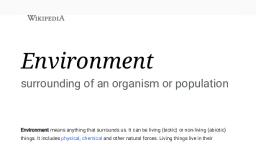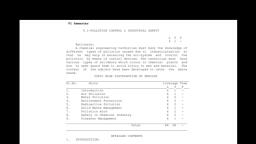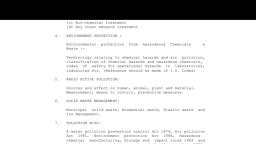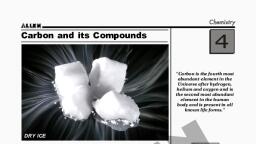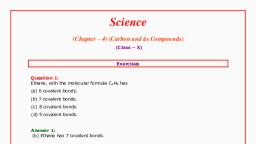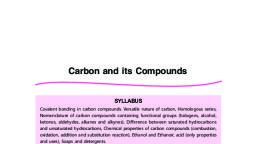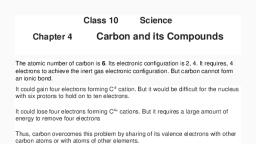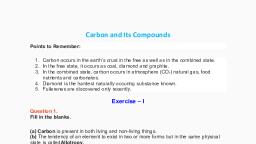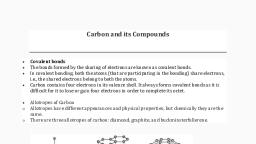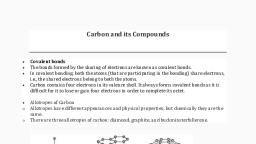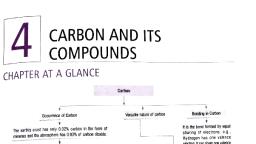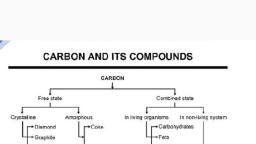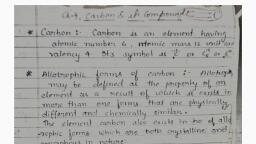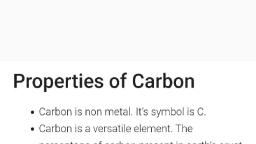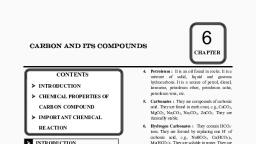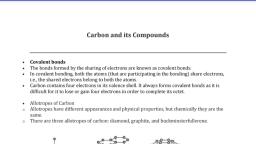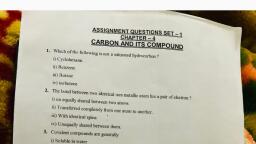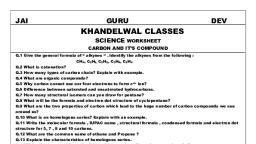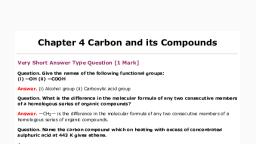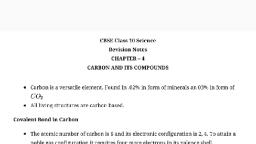Page 1 :
Class X – Science (Chemistry), Carbon and its Compounds, •, •, , •, •, •, , Chapter Notes, , Carbon is an element which plays a very important role in our lives, Importance of Carbon – carbon is an important constituent of the following• Foods (starch, sugar, fats, vitamins, proteins have carbon), • Fuels (wood, coal, alcohol, petrol), • Household and commercial articles (paper, soap, cosmetics, oils, paints), • Textile fabrics (cotton, wool, silk, linen, rayon, nylon), • Drugs (penicillin, quinine, aspirin etc), • Poisons (opium), • Perfumes(vanillin, camphor), • Explosives (nitroglycerine, dynamite, TNT), • Dyes [indigo, congo red, malachite green), • War gases (mustard gas, chloropicrin), The above listed compounds are of plant or animal origin and are called organic, compounds and their chemistry is known as "Organic Chemistry"., The earth's crust has only 0.02% carbon in the form of minerals (like petroleum, coal,, carbonates and hydrogen carbonates) and the atmosphere comprises of only 0.03% of, carbon dioxide., The properties of carbon which are responsible for such large number of compounds are1. Carbon forms covalent bonds, 2. Carbon shows Tetravalency, 3. Catenation- Property to bind with other carbon atoms, , Covalent Bonds, •, •, , Bonds formed by sharing of electrons are called covalent bonds., Covalent bonds are strong bonds., , Types of Covalent Bonds, 1. Single Bond, •, •, •, , Bond formed by sharing of one pair of electrons is called a single bond., It is represented by a small horizontal line (__)., E.g. a ) Formation of Hydrogen Molecule takes place by formation of a single, covalent bond., - Hydrogen atom has only one electron in its outermost shell, and requires one, more electron to acquire the nearest noble gas configuration of helium, - To do so, two hydrogen atoms share one pair of electrons between them., - This leads to the formation of a single covalent bond between the two, hydrogen atoms., , b) Formation of Chlorine Molecule takes place by formation of a single bond, -, , Chlorine atom has seven valence electrons., Thus, each Chlorine atom requires one more electron to acquire the nearest, noble gas configuration (Ar:2, 8, 8)., , Page 1, Neela Bakore Tutorials
Page 2 :
Class X – Science (Chemistry), Carbon and its Compounds, , Chapter Notes, , - This they do by mutual sharing of one pair of electrons as shown below., , 2. Double Bond, •, •, •, , Double bonds are formed by sharing of two pairs of electrons., It is represented by two horizontal lines (=)., E.g., - Formation of Oxygen Molecule takes place by formation of a double bond, - An oxygen atom has six electrons in its valence shell., - As a result, it requires 2 more electrons to achieve the nearest noble gas, (Neon) configuration., , 3. Triple Bond, •, •, •, , Triple bonds are formed by sharing of three pairs of electrons., It is represented by three horizontal lines ( ), E.g., - Formation of Nitrogen Molecule takes place by formation of a triple bond, - Nitrogen atom has five electrons in its valence shell., - It requires three more electrons to acquire a stable configuration of the, nearest noble gas (neon)., - This is done by mutually sharing three pairs of electrons., , Tetravalency in Carbon, •, •, •, •, •, •, , A carbon atom has a total of six electrons., 2 electrons occupy the first shells i.e., the K-shell, 4 electrons occupy L-shell., Therefore, a carbon atom has four valence electrons., It could gain four electrons to form C4- anion or lose four electrons to form C4+ cation., But carbon undergoes bonding by sharing its valence electrons., This allows it to be covalently bonded to one, two, three or four carbon atoms or atoms of, other elements or groups of atoms., , Page 2, Neela Bakore Tutorials
Page 3 :
Class X – Science (Chemistry), Carbon and its Compounds, , Chapter Notes, , Example, 1. Methane Molecule, •, •, •, , Carbon atom has four electrons in its outermost shell., Thus, it requires four more electrons to acquire a stable noble gas configuration., Each of the hydrogen atoms has only one electron in its outermost shell and requires one, more electron to complete its outermost shell (to acquire He configuration)., , 2 Carbon Dioxide Molecule, •, , The electronic configurations of carbon and oxygen are:, , •, , Thus, each carbon atom requires four, and each oxygen atom requires two more electrons, to acquire noble gas configurations., To achieve this, two oxygen atoms form a double covalent bond with carbon as follows., , •, , 3 Acetylene Molecule, •, •, •, •, , Carbon atom has four electrons in its outermost shell and hydrogen atoms have only one, electron in its outermost shell., Carbon share one of its electrons with hydrogen to form a single bond each., Each carbon then requires three more electrons to acquire a stable configuration of the, nearest noble gas (neon)., This is done by mutually sharing three pairs of electrons between the two carbon atoms to, form a triple bond as shown below., , Allotropes of Carbon, •, , •, , The existence of one element in different forms, having different physical properties, but, similar chemical properties is known as allotropy., Carbon shows allotropy., , Page 3, Neela Bakore Tutorials
Page 4 :
Class X – Science (Chemistry), Carbon and its Compounds, , Chapter Notes, , •, •, , Such different forms are called 'allotropes' of an element or allotropic forms., The various allotropic forms of carbon can be broadly classified into two classes., Crystalline form: Diamond, Graphite, Buckminster Fullerene, Amorphous form: Coal, Coke, Charcoal (or wood charcoal), Animal Charcoal., • Diamonds and graphite are two crystalline allotropes of carbon., • Diamond and graphite both are covalent crystals. But, they differ considerably in their, properties, , Comparison of the Properties of Diamond and Graphite, Diamond, , Graphite, , • It occurs naturally in free state, , • It, occurs, naturally, manufactured artificially., , • It is the hardest natural substance known., , • It is soft and greasy to touch, , • It has high relative density (about 3.5)., , • Its relative density is 2.3, , and, , is, , • It is transparent and has high refractive • It is black in colour and opaque, index (2.45)., • It is a bad conductor of electricity, but a • Graphite is a good conductor of heat, good conductor of heat., and electricity., • It burns in air at 900°C to give CO2., , • It bums in air at 700-800 °C to give, CO2., , • It occurs as octahedral crystals., , • It occurs as hexagonal crystals., , • It is insoluble in all solvents., , • It is insoluble in all ordinary solvents, , •, •, •, , These differences in the properties of diamond and graphite are due to the difference in, their structures., In diamond, each C atom is linked to its neighbouring carbon atoms by four single, covalent bonds., This leads to a three-dimensional network of covalent bonds., , Page 4, Neela Bakore Tutorials
Page 5 :
Class X – Science (Chemistry), Carbon and its Compounds, •, •, •, •, •, •, •, •, •, •, •, •, •, , Chapter Notes, , In graphite, the carbon atoms are arranged in flat parallel layers as regular hexagons., Each carbon in these layers is bonded to three other carbon atoms by covalent bonds., Graphite has one electron free or unshared (this is responsible of its property to conduct, electricity)., The layers are held together by weak Van der Waals forces., This allows each layer to slide over the other easily., Due to this type of structure graphite is soft and slippery, and is used as a lubricant., Graphite is also a good conductor of electricity due to a free mobile electron in it., Buckminster Fullerene (C 60), contains 60 carbon atoms., It 20 , six membered rings (hexagons) and 12 five membered rings( pentagons), The structure resembles the Geodesic Domes designed by US architect Buckminster, Fuller, so this allotrope of carbon is named as Buckminster Fullerene., It is a dark solid at room temperature., It is a very small molecule (only 60 carbon atoms) as compared to Diamond and, Graphite., It is neither very hard like Diamond nor very soft like Graphite., , Versatile Nature of Carbon, •, , •, , •, , The unique nature of carbon atom and the arrangement of the bond carbon forms with, other atoms enable the existence of such a large number of organic compounds., Tetravalent Nature -Due to its tetravalent nature carbon always form covalent bonds, by sharing electrons with one, two, three or four carbon atoms or atoms of other elements, or groups of atoms ., , The tetra covalency of carbon atom allows it to combine easily with other carbon atoms., This property of carbon to combine with other carbon atoms to form a stable chain like, structure is called Catenation., , Types and number of bonds, Carbon atom linked to four other, atoms with four single bonds., , Structure, , Page 5, Neela Bakore Tutorials
Page 6 :
Class X – Science (Chemistry), Carbon and its Compounds, , Chapter Notes, , Carbon atom linked to three atoms, with two single and one double bond., Carbon atom linked to two atoms, with one single and one triple bond., , Saturated and Unsaturated Carbon Compounds, •, , •, , The most numerous and important compounds that carbon forms are those with, hydrogen. These compounds are known as Hydrocarbons., On the types of bonds found in them , they are classified as -, , 1. Saturated Carbon Compounds, , •, •, •, •, •, , Compounds of carbon and hydrogen whose adjacent carbon atoms contain only one, (carbon-carbon) bond are known as saturated hydrocarbons., Their carbon-hydrogen bonds are also single covalent bonds., They are called saturated compounds because all the four bonds of carbon are fully, utilized and no more hydrogen or other atoms can attach to it., Thus, they can undergo only substitution reactions., These saturated hydrocarbons are called as alkanes., , 2. Unsaturated Hydrocarbons, •, , •, •, •, , Compounds of carbon and hydrogen that contain one double covalent bond between, carbon atoms (carbon=carbon) or a triple covalent bond between carbon atoms, (Carbon Carbon ) are called unsaturated hydrocarbons., In these molecules, since all the bonds of carbon are not fully utilized by hydrogen atoms,, more of these can be attached to them., Thus, they undergo addition reactions (add on hydrogen) as they have two or more, hydrogen atoms less than the saturated hydrocarbons, Unsaturated hydrocarbons can be divided into 'alkenes' and 'alkynes' depending on the, presence of double or triple bonds respectively., , Nomenclature of Carbon Compounds, •, •, , "Nomenclature is the system of assigning a proper name to a particular carbon compound, on the basis of certain rules.", Most of the carbon compounds have two types of names:, a) Common Names, • They are derived mostly from the source of the compound e.g., the name of, formic acid is derived from 'formicus' the Greek word meaning red ants., , b) IUPAC Names, •, •, •, , A committee called the 'International Union for Pure and Applied, Chemistry' (IUPAC) put forward a system of giving proper scientific names, to carbon based compounds., The names derived by their rules are the names followed all over the world, and in short are called IUPAC names., In this system the name of a carbon compound has three main parts as, mentioned below:, , Page 6, Neela Bakore Tutorials
Page 7 :
Class X – Science (Chemistry), Carbon and its Compounds, , Chapter Notes, , •, , Root Word -This denotes the number of carbon atoms present in a given, molecule. For e.g., C1-Meth, C2- Eth, C3 - Prop, C4- But., • Suffix - The suffix denotes the type of bonds or the functional group present, in the carbon chain., Type of bond, Suffix used, single bond, 'ane', double bond, 'ene', triple bond, 'yne', • Prefix -this denotes the presence of other functional groups and their, position., • Some of the functional groups are indicate by prefix and some by suffix, • For e.g., the following compound can be named as:, , Root Word : But (C4), , Prefix: 3, chloro, Suffix: -ol, , Name: 3-chloro butanol, Functional group, Chlorine, Bromine, Alcohol, Aldehyde, Ketone, Carboxylic acid, , Prefix, Chloro, Bromo, , Suffix, , ol, al, one, oic acid, , Common, IUPAC Names and Molecular Formula of some Organic Compound, Common name, Methane, , IUPAC name, Methane, , Ethane, , Ethane, , Ethylene, , Ethene, , Acetylene, , Ethyne, , Formaldehyde, Acetaldehyde, , Methanal, Ethanal, , Formic acid, Acetic acid, , Methanoic acid, Ethanoic acid, , Page 7, Neela Bakore Tutorials, , Formula
Page 8 :
Class X – Science (Chemistry), Carbon and its Compounds, , Chapter Notes, , Chain, Branched and Ring strictures of carbon compounds, •, •, , The properties of tetravalency and catenation allow the formation stable chains of carbon, atoms having different chain lengths and structures., The chains of carbon atoms may be linear or branched (open) or cyclic (closed) rings,, sheets and three-dimensional lattices. For example,, , Structure, , The compounds can be branched when the carbon atoms are more than three., Some of the examples are:, , Name, , Formula, , No. of, carbon, atoms, , Methane, , CH4, , 1, , Ethane, , C2H6, , 2, , Structure (straight), , Page 8, Neela Bakore Tutorials, , Structure (branched)
Page 9 :
Class X – Science (Chemistry), Carbon and its Compounds, , Propane, , C3H8, , Chapter Notes, , 3, , Iso-butane, , Butane, , C4H10, , 4, , Iso-pentane, , Pentane:, , •, •, , C5H12, , 5, , The branched chains give rise to a different structure to the parent alkane and are named, differently., For example, in pentane (C5H12) one can see a straight chain (normal pentane), branched, chain (Iso-pentane) and ring of cyclopentane (C5H10)., , Thus when carbon having different chain lengths and structures combines with different elements, it leads to the formation of a large number of compounds., , Page 9, Neela Bakore Tutorials
Page 10 :
Class X – Science (Chemistry), Carbon and its Compounds, , Chapter Notes, , Isomerism, •, •, •, •, •, , The unique feature of the carbon-carbon bonding has also led to the formation of, compounds that can have the same molecular formula, but different structures., This phenomenon of different structural formula of the same molecule, giving rise to, different properties of compounds, is called Isomerism., In the above illustrations pentane and iso-pentane display isomerism., Such compounds with the same molecular formula are called isomers of one another., Another common instance of isomerism is butane, where there are following two possible, structures for the same molecular formula C4H10., , Homologous Series, •, , All organic compounds are made up of a progressively building chain of carbon atoms, with a number of compounds having the same functional groups., • Such a series of similarly constituted compounds are called a homologous series., • Members of a homologous group are similar in structure and display similar chemical, characteristics., • The two consecutive members of the series differ in their molecular formula by a 'CH2', group., Some important characteristics of the homologous series are:, •, •, •, •, , All the members conform to a general molecular formula and have a similar functional, group., Each consecutive member differs in the molecular formula by a unit of 'CH2'., All the members of the series exhibit similar properties, but the extent of the reactions, varies with increasing relative molecular mass., The physical properties, such as solubility, melting point, boiling point, specific gravity, etc. show a gradual change with the increase in their relative molecular masses., , Chemical Properties of Carbon Compounds, 1. Combustion, •, •, •, , Combustion means the burning of a substance., It is a process that is highly exothermic i.e., produces a lot of heat., The products of combustion of carbon and its compounds are carbon dioxide, water (vapour), and a large amount of heat energy is released., , The basic things required for combustion are • A combustible substance: All carbon compounds are combustible, but carbon as diamond is, not. Petrol is a combustible substance., , Page 10, Neela Bakore Tutorials
Page 11 :
Class X – Science (Chemistry), Carbon and its Compounds, •, •, , •, , Chapter Notes, , A supporter of combustion: Atmospheric air or oxygen gas is a supporter of combustion. In, their absence, combustion will not be supported. Carbon dioxide or nitrogen gases do not, support combustion., Heating to ignition temperature: A minimum amount of temperature or heat is required to, enable a fuel to catch fire. Coal has a high ignition temperature; a matchstick cannot produce, enough heat to ignite it. However, a matchstick can ignite paper or LPG gas as it has low, ignition temperature., For example, if an ideal fuel like LPG (high calorific value and relatively high, amounts of branched hydrocarbons) is available, a sufficient and continuous supply of, oxygen should be maintained to burn it. If the ignition spark or flame is sufficient then, the combustion is smooth and complete as follows., , •, , •, , It produces high heat energy with no wastage of raw material (un-reacted) and no, production of undesirable by products (pollutants)., Most of the carbon compounds like the hydrocarbons when burnt in air or oxygen, produce large amounts of heat, together with carbon dioxide and water vapour formation., Hence they are used as fuels., For example, methane burns with a blue flame in air., , •, , In a very limited supply of air methane gives carbon black., , •, , 2. Oxidation, •, •, , •, , Carbon undergoes oxidation by combining with oxygen at higher temperature to form to, oxides, viz., carbon monoxide (CO) and carbon dioxide (CO2)., Carbon monoxide is formed, when incomplete combustion of carbon or carbon, containing fuels takes place, , CO is present in automobile exhausts (when there is incomplete combustion), volcanic, gases, chimney gases etc., , Page 11, Neela Bakore Tutorials
Page 12 :
Class X – Science (Chemistry), Carbon and its Compounds, , Chapter Notes, , Addition Reaction, •, , The reactions in which two molecules react to form a single product are called addition, reactions. For example,, , •, , Carbon containing double bonds like the alkenes readily react with certain molecules to, form saturated addition products., The addition of Cl2, Br2 or I2 molecule across the double bond of the alkene is called, halogenations, , •, , •, , The addition of a hydrogen molecule across the double bond of the alkene to form, saturated products is called hydrogenation. This takes place in the presence of the, catalyst, nickel., , Page 12, Neela Bakore Tutorials
Page 13 :
Class X – Science (Chemistry), Carbon and its Compounds, , Chapter Notes, , Substitution Reaction, •, , The reactions in which an atom or group of atoms in a molecule is replaced or substituted, by different atoms or group of atoms are called substitution reaction. For example,, , •, , In substitution reactions the hydrogen of the alkane molecule is replaced by another atom, or a group of atoms (like alkyl) resulting in the formation of the derivatives of that, hydrocarbon., Substitution by halogen atom is generally called halogenation., This type of substitution results in chlorination, bromination or iodination., , •, •, , Chlorination of Methane, •, •, , •, , Chlorination of methane is carried out by taking a mixture of methane and chlorine in the, sunlight or by heating to a temperature of 250o- 300oC., If chlorine is in excess, a number of substitution products are obtained., , Like methane, ethane also forms a series of substitution products in the presence of, excess chlorine and sunlight., , Page 13, Neela Bakore Tutorials
Page 14 :
Class X – Science (Chemistry), Carbon and its Compounds, , Chapter Notes, , Some Important Carbon Compounds, Ethanol or Ethyl Alcohol, •, •, , Usually the term 'alcohol' refers to ethanol. Man has been using ethanol for thousands of, years especially in the form of wine., The structural formula of ethanol is given as follows:, , •, •, •, •, •, •, , Its molecular formula is CH3CH2OH or C2H5OH, Ethanol is colorless liquid and has a pleasant odour., Its boiling point is 78o C and its freezing point is -114oC., It is soluble in water and almost all the organic solvents., It is highly intoxicating in nature., It is combustible and burns with a blue flame., , Properties of Ethanol, 1. Action with Sodium Metal, •, , •, , When a piece of sodium is dropped in ethyl alcohol, bubbles of hydrogen gas are, observed., This property can be used as a test for Ethanol ( Hydrogen gas released burns with a pop, sound), , 2 Dehydration, •, •, , Action with Concentrated Sulphuric Acid, At 170oC ethyl alcohol undergoes dehydration when treated with concentrated H2SO4 to, form ethane, , •, , At lower temperature of 140oC and when present in excess ethyl alcohol forms a pleasant, smelling substance called diethyl ether., , Page 14, Neela Bakore Tutorials
Page 15 :
Class X – Science (Chemistry), Carbon and its Compounds, , Chapter Notes, , 3. Oxidation of Ethyl Alcohol by Acidified Potassium Dichromate, •, •, , Alcohols on oxidation give aldehydes. The aldehydes on further oxidation give, carboxylic acids., Acidic K2Cr2O7 (K2Cr2O7 + H2SO4) OR Alkaline KMnO4 (KMnO4 + NaOH) are, used as oxidizing agents , they give nascent oxygen (free atom of oxygen [ O ]), , Uses, All these are important chemical compounds used further by chemical industries., • Ethyl Alcohol is used as a solvent for many organic solutes, especially which are, insoluble in water., • It is used in the preparation of perfumes., • It is used in the manufacturing of gasohol, which is 90% mixture of petrol (gasoline) and, 10% ethanol. It helps to save gasoline., • Ethyl Alcohol is used in making tinctures and medical syrups., • It is used in alcoholic beverages., • It is used as a solvent for paints, varnishes, dyes etc., • It is used in the production of many organic compounds., , Effect of Alcohol on Human Beings, •, , •, •, •, •, •, •, , Chemically the term alcohol refers to a group of organic compounds, having, -OH group in their composition., But the word alcohol used by the common man refers to ethyl alcohol or ethanol., It has a variety of uses, especially as a solvent. But by far the greatest use of alcohol is in, the form of alcoholic beverages, such as wine, beer, rum, brandy, whisky etc.in large, amounts, it affects the nervous system., On consumption of alcohol the, person experiences loss of control over muscles and loses, sense of balance and mental ability., It can be a habit forming activity., If consumed over a period of time, alcohol can ruin one's health especially the liver,, which gets affected by cirrhosis., Long term consumption can be fatal and ruins one's family life., , Methylated Spirit or Denatured Alcohol, •, •, •, •, •, , Alcoholic drinks are heavily taxed by the government, so as to discourage people from, over consuming it., Alcohol used for industrial and surgical purposes is not taxed heavily., In order to prevent people form buying and consuming this alcohol, ethyl alcohol is, mixed with a certain percentage of highly poisonous methyl alcohol or methanol., This renders the ethyl alcohol unfit for human consumption. This mixture is called, "Methylated Spirit"., Methanol damages the optic nerves and can cause to blindness., , Page 15, Neela Bakore Tutorials
Page 16 :
Class X – Science (Chemistry), Carbon and its Compounds, •, •, , Chapter Notes, , If chemicals like copper sulphate or pyridine are added to ethyl alcohol it is called, 'denatured alcohol'., Both, methylated spirit and denatured alcohol are toxic if consumed, , ., Ethanoic Acid, •, •, •, •, •, •, •, , Acetic acid is one of the commonest organic acids and has been known for quite a long, time in the form of vinegar., Formula: CH3COOH, IUPAC Name: Ethanoic acid, Acetic acid is a colourless, corrosive liquid with a pungent smell at ordinary, temperatures., But below 290K, pure acetic acid solidifies to an icy mass called glacial acetic acid., It boils at 391K and its specific gravity is 1.08 at 273K., It is miscible with water, alcohol and ether in all ratios., It is a good solvent for phosphorus, sulphur, iodine and inorganic compounds., , 1 Reactions of Alkyl Group - Halogenation, •, , In acetic acid, halogen atoms successively replace the three hydrogen atoms of the alkyl, group., , Reactions Involving Replaceable Hydrogen Atom, Acetic acid ionizes in polar media to give hydrogen ion that is responsible for its acidic, behaviour., , Accordingly, acetic acid can react with alkalis and alkali metal carbonates and also with metals., , 2 With Alkalis, Carbonates and Bicarbonates, •, , Acetic acid turns blue litmus to red, neutralizes alkalis to form salt and water. It also, decomposes carbonates and bicarbonates to liberate carbon dioxide indicated by, effervescence., , Page 16, Neela Bakore Tutorials
Page 17 :
Class X – Science (Chemistry), Carbon and its Compounds, •, , Chapter Notes, , Bicarbonate test is used as an identification test for the presence of carboxylic group in a, compound., , 3 With Metals, •, , Acetic acid reacts with strongly electropositive metals like sodium and zinc to give the, respective acetate and liberate hydrogen., , 4. With Alcohols, •, , Acetic acid reacts with alcohols in the presence of dehydrating agents like anhydrous zinc, chloride or concentrated sulphuric acid to form esters, , 5 Oxidation, •, , On prolonged heating with a strong oxidizing agent, acetic acid is oxidized to carbon, dioxide and water, , Uses, •, •, •, •, •, •, , Ethanoic aid is used in the manufacture of dyes, perfumes and rayons, Manufacture of rubber from latex and casein from milk. It is used for coagulation., In the form of salts in medicine and paints., In the form of acetates of aluminium and chromium is used as mordants., In dilute form is used as vinegar and in the concentrated form as a solvent., In form of organic esters as perfumes, , Soaps and Detergents, •, •, •, •, , •, •, •, , Soaps or detergents are cleansing agents that are capable of reacting with water to, dislodge these foreign particles from a solid surface (e.g. cloth or skin)., Chemically speaking, Soaps are sodium or potassium salts of higher fatty acids like, stearic, palmitic and oleic acids can be either saturated or unsaturated., They contain a long hydrocarbon chain of about 10-20 carbon with one carboxylic acid, group as the functional group., Saturated fatty acids such as stearic and palmitic etc. contain only single bonds in their, molecule, while unsaturated fatty acids such as oleic, linoleic etc., contain one or more, double bonds. Thus, soaps are usually a mixture of the sodium salts of the following, acids:, Stearic acid as sodium stearate (C17H35COONa) - saturated fatty acid; from vegetable oils, like linseed oil, soyabean oil., Palmitic acid as sodium palmitate (C15H31COONa) - saturated fatty acid; Palm oil, animal, fat, Oleic acid as sodium oleate (C17H33COONa) - unsaturated fatty acid; Vegetable oils like, linseed oil, soyabean oil., , Page 17, Neela Bakore Tutorials
Page 18 :
Class X – Science (Chemistry), Carbon and its Compounds, •, •, •, , Chapter Notes, , When soap is made from the sodium salts of the acids of cheap oils or fats, the resulting, soap is hard., These soaps contain free alkalis and are mainly used as washing bars for laundry., When soap is prepared from the potassium salts of the acids of good grade oils and fat, it, results in soft soap. These soaps do not contain free alkalis. They produce more lather, and are used mainly as toilet soaps, shaving cream and shampoos., , Difference between Toilet Soap and Laundry Soap, Toilet Soap, , Laundry Soap, , High quality fats and oils as raw materials., , Cheaper quality fats and oils., , Expensive perfumes added., , Cheap perfumes added., , Care is taken to ensure that there is no free No such care is taken., alkali content to prevent injuries to skin., No fillers., , Fillers present., , . Cleansing Action of Soap, •, •, , •, •, , A soap molecule at one end has the long hydrocarbon chain that is non-polar and, hydrophobic, i.e., insoluble in water but oil soluble., At the other end is the short polar carboxylate ion which is hydrophilic i.e., water soluble, but insoluble in oil and grease., , When soap is shaken with water it becomes a soap solution that is colloidal in nature., Agitating it tends to concentrate the solution on the surface and causes foaming. This, helps the soap molecules make a uni-molecular film on the surface of water and to, penetrate the fabric., , Page 18, Neela Bakore Tutorials
Page 19 :
Class X – Science (Chemistry), Carbon and its Compounds, •, •, •, , Chapter Notes, , The long non-polar end of a soap molecule that are hydrophobic, gravitate towards and, surround the dirt (fat or oil with dust absorbed in it)., The short polar end containing the carboxylate ion, face the water away from the dirt., A number of soap molecules surround or encircle dirt and grease in a clustered structure, called 'micelles', which encircles such particles and emulsify them., , Limitations of Soaps, • Soaps do not wash well in hard water and does not form much lather or foam., • The calcium, magnesium or iron ions of hard water form an insoluble sticky gray, coloured precipitate called scum, which restricts the cleansing action of soap and makes, washing more difficult., • The scum formed also hardens and decolorizes the fabric., • Thus, a large amount of soap is wasted and cleaning is not efficient., • Ordinary soaps are not suited for fabrics such as silks, wool etc., • To overcome these drawbacks new types of chemical based cleansing agents were, developed., • These are called synthetic detergents or simply detergents., , Synthetic Detergents, •, , •, •, •, •, •, •, , A detergent is a non-soapy cleaning agent that uses a surface-active agent for cleaning a, substance in solution., Synthetic detergents are described as soapless soaps., Unlike soaps they are effective even in hard or salt water, as they form no scum., Modern synthetic detergents are alkyl or aryl sulphonates produced from petroleum (or, coal) and sulphuric acid., They can be defined as 'the sodium or potassium salt of a long chain alkyl benzene, sulphonic acid or the sodium or potassium salt of a long chain alkyl hydrogen sulphate, that have cleansing properties in water'., Like soaps, detergents contain one large non-polar hydrocarbon group and one short ionic, or highly polar group at each end, which allow for the cleansing action of dirt in water., Two basic examples of well-known detergents of the sulphonate group, are:, , or the sulphate group, , Cleansing Action of Detergents, •, , •, •, , Synthetic detergents have the same type of molecular structure as soaps i.e., one large, non-polar hydrocarbon group that is water repelling (hydrophobic) and one short ionic, or, group that is water attracting, group usually containing the, (hydrophilic)., Thus the cleansing action is exactly similar to that of soaps whereby the formation of, micelles followed by emulsification occurs., However, synthetic detergents can lather well even in hard water., , Page 19, Neela Bakore Tutorials
Page 20 :
Class X – Science (Chemistry), Carbon and its Compounds, •, •, , Chapter Notes, , This is because they are soluble sodium or potassium salts of sulphonic acid or alkyl, hydrogen sulphate and similarly form soluble calcium or magnesium salts on reacting, with the calcium ions or magnesium ions present in water., This is a major advantage of the cleansing property of detergents over soap., , Advantages of Detergents, •, , •, •, •, , •, , Synthetic detergents clean effectively and lather well even in hard water and salt water, (sea water). There is no scum formation., Since detergents are the salts of strong acids they do not decompose in acidic medium., Thus detergents can effectively clean fabric even if the water is acidic., Synthetic detergents are more soluble in water than soaps., They have a stronger cleansing action than soaps., As detergents are derived from petroleum they save on natural vegetable oils, which are, important as essential cooking medium., , Disadvantages of Detergents, •, •, •, •, , Detergents are surface-active agents and cause a variety of water pollution problems., Many detergents are resistant to the action of biological agents and thus are not, biodegradable. Their elimination from municipal wastewaters by the usual treatments is a, problem., They have a tendency to produce stable foams in rivers that extend over several hundred, meters of the river water. This is due to the effects of surfactants used in their preparation., Thus they pose a danger to aquatic life., They tend to inhibit oxidation of organic substances present in wastewaters because they, form a sort of envelope around them., , Differences between Soaps and Detergents, Soaps, , Detergents, , They are metal salts of long chain higher, fatty acids., , These are sodium salts of long chain, hydrocarbons like alkyl sulphates or alkyl, benzene sulphonates., , These are prepared from vegetable oils and, animal fats., , They are prepared from hydrocarbons of, petroleum or coal., , They cannot be used effectively in hard, water as they produce scum i.e., insoluble, precipitates of Ca2+, Mg2+, Fe2+ etc., , These do not produce insoluble precipitates, in hard water. They are effective in soft,, hard or salt water., , These cannot be used in acid solutions., , They can be used even in acid solutions., , Their cleansing action is not as strong as, that of detergents., , Their cleansing action is by surfactants,, which is a strong cleansing action., , These are biodegradable., , Some of these are not biodegradable., , Page 20, Neela Bakore Tutorials

